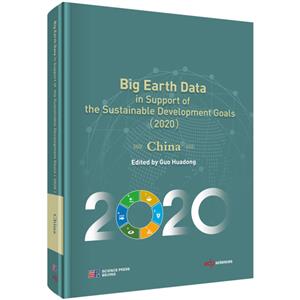-
>
公路車寶典(ZINN的公路車維修與保養秘籍)
-
>
晶體管電路設計(下)
-
>
基于個性化設計策略的智能交通系統關鍵技術
-
>
花樣百出:貴州少數民族圖案填色
-
>
山東教育出版社有限公司技術轉移與技術創新歷史叢書中國高等技術教育的蘇化(1949—1961)以北京地區為中心
-
>
鐵路機車概要.交流傳動內燃.電力機車
-
>
利維坦的道德困境:早期現代政治哲學的問題與脈絡
地球大數據支撐可持續發展目標報告(2020):中國篇(英文版) 版權信息
- ISBN:9787030675248
- 條形碼:9787030675248 ; 978-7-03-067524-8
- 裝幀:一般膠版紙
- 冊數:暫無
- 重量:暫無
- 所屬分類:>>
地球大數據支撐可持續發展目標報告(2020):中國篇(英文版) 內容簡介
《地球大數據支撐可持續發展目標報告(2020):中國篇》圍繞零饑餓(SDG2)、清潔飲水和衛生設施(SDG6)、可持續城市和社區(SDG11)、氣候行動(SDG13)、水下生物(SDG14)和陸地生物(SDG15)6個可持續發展目標(SDGs)所開展的42個案例研究、指標建設和可持續發展狀態評估,展示了中國和典型地區兩個尺度在數據、方法模型和決策支持方面對相關SDGs及其指標進行的研究和監測評估成果,包括41套數據產品、21種方法模型和30個決策支持結果。這些案例展現了中國利用科技創新推動落實聯合國“2030年可持續發展議程”的探索和實踐,充分揭示了地球大數據技術對監測評估可持續發展目標的應用價值和廣闊前景,開拓了在聯合國技術促進機制框架下利用大數據、人工智能等優選技術方法支撐“2030年可持續發展議程”落實的新途徑和新方法,為各國加強“2030年可持續發展議程”的落實監測評估提供借鑒。
地球大數據支撐可持續發展目標報告(2020):中國篇(英文版) 目錄
Foreword i
Preface v
Executive Summary ix
List of Cases on Big Earth Data for SDGs xv
Chapter 1 Introduction
Challenges to Implementing the SDGs / 2
Big Earth Data / 3
Big Earth Data in Support of SDGs / 4
Chapter 2 SDG 2 Zero Hunger
Background / 8
Main Contributions / 10
Case Study / 11
The trend of under-f ive stunting in China / 11
Potential for sustainable cropland intensif ication in China / 17
Potential for improvement of the sustainability of crop production in China / 22
Monitoring and early warning of agri-product price volatility in China / 28
Summary / 34
Chapter 3 SDG 6 Clean Water and Sanitation
Background / 38
Main Contributions / 39
Case Study / 41
Spatiotemporal patterns of water transparency in China’s lakes / 41
Water-use eff iciency and its change in China / 47
Evaluation of water stress in the Shule River Basin in Northwest China / 53
Changes in the spatiotemporal extent of China’s vegetated wetlands / 59
Spatial distribution and changes of aquatic vegetation and algae in typical lake ecosystems, China / 65
Comprehensive analysis of the sustainable development of water security in China / 71
Summary / 77
Chapter 4 SDG 11 Sustainable Cities and Communities
Background / 80
Main Contributions / 81
Case Study / 84
Estimates of population living in shantytowns as a percentage of main urban district residents in cities in China / 84
Proportion of the population with easy access to public transportation in China / 90
Monitoring and assessing urbanization progress in China / 96
Analysis of urban expansion and population growth in China / 104
Research on Sustainable Development Goals of UNESCO designated sites in China / 111
Monitoring of disaster loss reduction and promoting sustainable development in vulnerable areas in China / 119
Impact assessment of storm surge inundation in Shenzhen / 127
Monitoring and analyzing f ine particulate matter (PM2.5) in cities in China / 134
Assessment of urban public space in China / 139
Share of open public space area in cities in China / 148
Evaluation of the emergency response capacity for COVID-19 in Wuhan / 153
Xuzhou: A typical case of resource-exhausted cities and regional transformation routes / 167
Integrated assessment of SDG 11 indicators at the provincial scale in China / 180
Summary / 186
Chapter 5 SDG 13 Climate Action
Background / 190
Main Contributions / 191
Case Study / 192
Intensity and frequency of extreme high-temperature events and heatwaves in China / 192
Predicting the impacts of future climate change on the phenology of major crops in China / 198
Reaction of glaciers on the Qinghai-Tibetan Plateau to climate change / 203
Summary / 208
Chapter 6 SDG 14 Life below Water
Background / 212
Main Contributions / 213
Case Study / 215
Distribution and variation of marine debris and microplastics in China’s coastal waters / 215
Distribution of metal pollutants in coastal areas of China: using bivalves as bio-indicators / 223
Ecosystem health assessment for typical bays in coastal China / 229
Risk assessment of harmful algal blooms in the Bohai Sea / 235
Monitoring changes in raft culture in China’s coastal waters / 242
Eutrophication, hypoxia, and acidif ication in China’s coastal waters / 247
Summary / 253
Chapter 7 SDG 15 Life on Land
Background / 256
Main Contributions / 258
Case Study / 260
Forest type distribution along the Yangtze River basin, China / 260
Three conditions for biodiversity conservation and sustainable use in China / 265
Proportion of important sites for terrestrial, freshwater, and mountain biodiversity that are covered by protected areas / 272
Suitability of no net loss as a wetland protection target / 277
Large-scale vegetation restoration and soil & water conservation in the Loess Plateau of China in the past 20 years / 282
Evaluating aeolian desertif ication processes and restoration in the semi-arid region and its surrounding areas of northern China / 288
Salinization development and countermeasures in the Yellow River Delta / 295
China’s plant diversity: risks and conservation strategies / 300
Spatiotemporal changes in plant diversity in grassland nature reserves in northern China / 305
Distribution and development of pinewood nematode disease in China / 311
Summary / 317
Chapter 8 Summary and Prospects / 320
References / 324
Acronyms / 344
地球大數據支撐可持續發展目標報告(2020):中國篇(英文版) 節選
2 Challenges to Implementing the SDGs 3 Big Earth Data 4 Big Earth Data in Support of SDGs Chapter 1 Introduction In 2015, the United Nations Sustainable Development Summit adopted the 2030 Agenda for Sustainable Development, which proposed 17 Sustainable Development Goals (SDGs)covering economic, social, and environmental aspects. These goals represent the direction of national development and international cooperation. In the almost f ive years since their adoption,monitoring and evaluation of the SDGs have been constrained by a lack of data, varying capacities,and indicators that are both intertwined and mutually restrictive. The solutions to these pressingissues are entrusted to scientific and technological innovation. The CASEarth, drawing on Big Earth Data’s strengths in multi-scale and near real-time processing and system integration, hasreleased annual scientific evidence-based monitoring results for six SDGs, including SDG 2 (ZeroHunger), SDG 6 (Clean Water and Sanitation), SDG 11 (Sustainable Cities and Communities),SDG 13 (Climate Action), SDG 14 (Life below Water), and SDG 15 (Life on Land). The reports represent a concrete contribution to the implementation of SDGs. Challenges to Implementing the SDGs The Global Indicator Framework for the Sustainable Development Goals and Targets of the 2030 Agenda for Sustainable Development was adopted by the United Nations (UN) in 2017. This framework serves as a voluntary preliminary system for the Member States to monitor progress towards the implementation of the SDGs. The framework is subject to regular ref inement and updates, and faces the following issues. (1) Lack of data. The previous situation related to the absence of evaluation methods and data has improved for all indicators over the past five years. However, despite the availability of methods, there is still a lack of data for 46% of all indicators. In regard to indicators where both methods and data are available, the results are largely measured via statistics without the support of spatial distribution information. Therefore, it is necessary to acquire spatial data that is objective and accurate, which including various spatial scales. Specifically, the data that is collected for scientific means can be used to regularly and quantitatively assess changes in the natural environment, accurately identify the spatial position of disasters, and predict their future trends. This refers to monitoring cases such as extreme high temperatures and heatwaves, the high frequency of f ires, ocean acidif ication, increased eutrophication, continued land degradation, reduced biodiversity, and increased environmental impact on agricultural production. (2) Imbalance in capacities. Developing countries are constrained in their ability to regularly and quantitatively collect and analyze data by their level of economic growth and the carrying capacity of resources and the environment. The lack of data has obfuscated serious issues such as the high ratio of stunting, the inadequacy of urban housing and public space, weak disaster resilience, the lack of access to safe drinking water, and the overuse of forests. Big Earth Data can be used to collect objective data at global, regional, and local scales in a timely, accurate, and comprehensive way. This can improve the compatibility and comparability of data, so that “no one is left behind” in regard to the information that is essential for SDG achievement. (3) The indicators are intertwined but mutually restrictive. SDG indicators are wideranging, long-term, and intertwined. These diverse and complex indicators consist of multiple tiers that come together to form a coherent, feasible whole. There is an urgent need to create methods and models for effective monitoring and evaluation based on compatible and quantifiable data. Big Earth Data The United Nations launched the Technology Facilitation Mechanism (TFM) to address the above-mentioned issues and challenges through Science, Technology and Innovation (STI). The initiative combines the collective wisdom of the scientific and business communities and stakeholders. Big Earth Data refers to large datasets in the Earth sciences that feature spatial attributes, especially the massive Earth observation data generated by space technology (Guo et al., 2016). Such data is mainly produced at large spatial scales by scientific devices, detection equipment, sensors, socio-economic observations, and computer simulation processes. Like other types of big data, Big Earth Data is massive, multi-source, heterogeneous, multi-temporal, multi-scale, and non-stationary. Moreover, Big Earth Data has strong spatiotemporal and physical correlations, and the data generation methods and sources are controllable. Big Earth Data science is interdisciplinary, encompassing natural sciences, social sciences, and engineering. It systematically studies the correlation and coupling of
- >
我與地壇
- >
小考拉的故事-套裝共3冊
- >
新文學天穹兩巨星--魯迅與胡適/紅燭學術叢書(紅燭學術叢書)
- >
朝聞道
- >
隨園食單
- >
企鵝口袋書系列·偉大的思想20:論自然選擇(英漢雙語)
- >
上帝之肋:男人的真實旅程
- >
詩經-先民的歌唱















